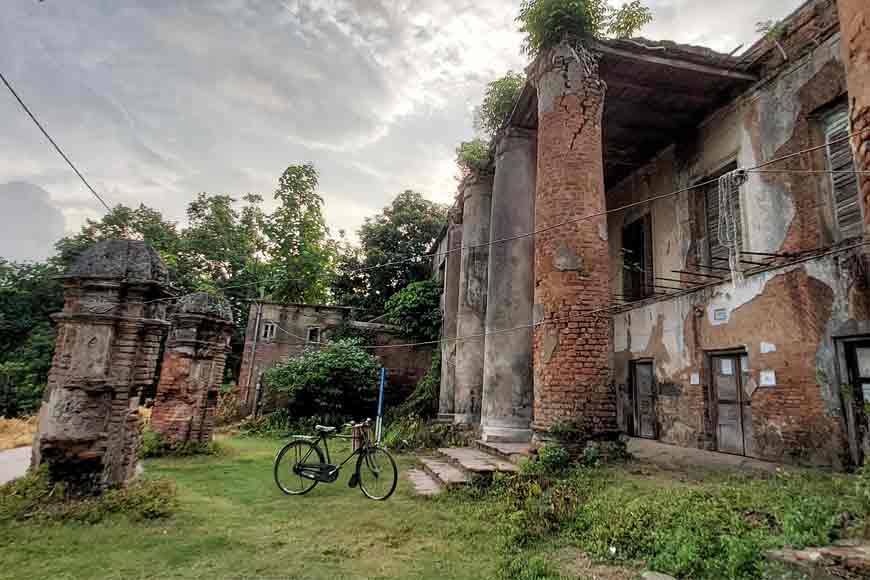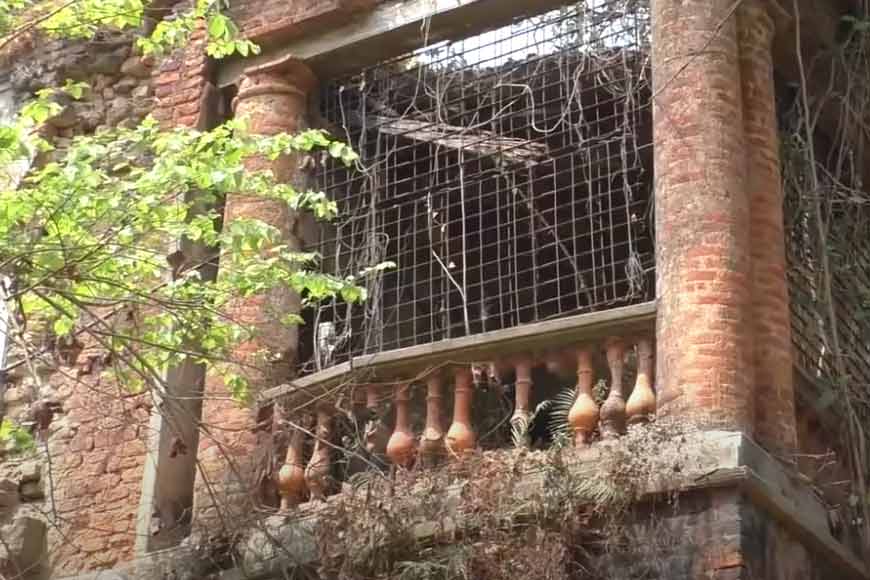Somra Palace and the Sukharia village in Hooghly district of Bengal – GetBengal story

Remember Mrinal Sen’s iconic film, Akaler Sandhaney? This national award-winning film was shot in Somrabazar. Steeped in history and flanked by the mighty Ganges, Somrabazar is known for its terracotta temples, the Somra Palace ruins, and Sabujdwip, a riverine island famous for being the purported seat of the spiritual awakening of Rani Rashmoni. The nearby attractions of Guptipara, Bandel, Balagarh, Hooghly, and Somrabazar also produce some of the best sweets in Bengal.

Here stands the rajbari of the erstwhile Zamindars, known as Somra Palace, which is now in complete ruins, though the lost grandeur is still evident from the doric columns, hanging balconies, and Durga Dalans. The Anandamoyee Temple in Sukharia village is one of the finest specimens of the 25-pinnacled terracotta temples of Bengal. Founded in 1763 AD, Anandamoyee Temple houses the main temple of Anandamoyee Maa, which is surrounded by 12 smaller temples. Although the present structure was completed in 1813 and most of the structure is in ruins, a few terracotta panels are still in good condition. The palace of the Mitra Mustafi family, known as Radha Kunja, still stands.

The quaint Sukharia village is on the busy Somra Bazar railway line in Hooghly district. It has been the home of some of the oldest Zamindar families, whose wealth, grandeur, and affluence have had a significant influence on the culture and lifestyle of the people of Somra Bazar. Sukharia is known for its Mitra Mustafi family. The earliest known member of this illustrious family of Kayasthas is Kalidas Mitra, who migrated from Kannauj. The most famous member of this family was Rameswar Mitra of the 19th generation from Ula-Birnagar, who rose from his position in the Accounts Department in the province of Bengal to the Accounts Department in the Mughal court on the recommendation of the Nawab of Bengal. Here, he met Mughal Emperor Aurangzeb, who was so impressed with his dedication as an accountant that he gave him the title of Mustafi or Mustauphi and presented him with a golden panja (palm) that is equivalent to the royal seal. The golden panja became the insignia for the Mitra Mustafis. They are thus known as a family of Diwans, as most of the family members served in different positions in the revenue departments during the Mughal period and British rule.

The entrance to the double-story palace is partly overtaken by vegetation, but the six Doric columns forming the portico can still be seen. The columns and façade of the palace are simple. The entrance is like a dark tunnel, like many North Kolkata mansions. Various storage and office rooms are present before reaching an inner grassy courtyard, where a raised Thakur Dalan steals the show, featuring five archways. The lower and upper levels again have doric columns of equal size, indicating that the entire palace was built in one go, and the family thus had considerable wealth to invest in such a huge palace. The upper-level columns are separated by wrought iron railings and fixed wooden shutters above.

The courtyard is unusual as it has a smaller, delineated space within, created by short pillars and linked by decorative iron panels, creating a smaller square compound with openings on the north and south sides. The pillars are topped by overhanging curved metal hooks, possibly to hang flower pots.

The other notable temples in Somrabazar are Harasundri Temple, built in 1814 AD, and Nistarini Temple, built in 1847 AD. The Siddheshwari Kalibari Temple on the banks of the Ganges may not be as structurally grand as the other temples of Somrabazar, but its spiritual and historical importance is immense. It is said that Rani Rashmoni, while sailing beside this temple, had a spiritual awakening and found the Dakshineshwar Temple. Rameswar Mitra and his successors are said to have built most of these beautiful temples and mansions.One of the finest examples is the Panchabingshati (twenty-five pinnacles or peaks)-styled Ananda Bhairavi Temple, built by Bireshwar Mitra Mustafi in 1813 by a lake. The layout of this temple is very interesting, as there are six temples on either side of the main temple. Five of these six temples are aatchala (eight roofs), and one is designed as a pancharatna (five pinnacles).

The main temple is a three-story structure that has three pinnacles at each corner on the first level, two pinnacles at each corner on the second level, one pinnacle at each corner on the third level, and an impressive central pinnacle. Anandamoyee Kali Mata is seated in the sanctum sanctorum of the main temple, while Shiva Lingas are seen in nine of the smaller temples and Lord Ganesha in one. The Hara Sundari Temple, built in 1814 in the navaratna style (nine pinnacles), was severely damaged in an earthquake in 1897. This temple is flanked by seven smaller temples and, at one time, had a grand, two-story entrance gate. Locals say that people used to be greeted by the sound of trumpets and kettledrums while entering the temple in the earlier days.

The Nistarani Kali Temple, built by Kashigati Mitra Mustafi in 1847, is a fine example of the navaratna style. This temple had a natmandir, which has collapsed, and only a few pillars remain in front of the temple. Provided with adequate funds, Somra palace and Sukharia village can easily be developed into a heritage village.










